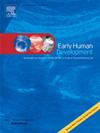Multi-organ involvement in preterm neonatal encephalopathy
IF 2
3区 医学
Q2 OBSTETRICS & GYNECOLOGY
引用次数: 0
Abstract
Background
Hypoxic-ischemic encephalopathy (HIE) is a complex condition resulting from oxygen deprivation at birth. As the body redirects cardiac output to protect the brain, this can lead to multiorgan dysfunction (MOD). While most previous studies traditionally focused on term neonates with HIE, our goal was to focus on preterm neonates to study the effect on organs during critical periods of brain development. We aim to assess the incidence and severity of MOD in relation to brain magnetic resonance imaging (MRI) findings and electroencephalogram (EEG) abnormalities in this vulnerable population.
Methods
Retrospective cohort review of preterm neonates (<35 weeks' gestation) with a diagnosis of neonatal encephalopathy (NE) admitted to the Neonatal Intensive Care Unit (NICU) at Parkland Hospital in Dallas between 2009 and 2023. MOD diagnosis of cardiac, renal, and liver function using clinical and laboratory markers, including echocardiography, serial troponin T, creatinine, urine output, as well as AST and ALT levels during the perinatal period.
Results
During the study period, 54 preterm neonates (incidence 0.4/1000) were diagnosed with HIE. All of them had one or more organ injuries and the majority suffered from MOD: 67 % had liver injury (AST 277.0 [68.0, 686.8] IU/L), 55 % had cardiac injury (Troponin T 0.3 [0.2, 0.6] Ng/mL), and 37 % had renal injury (oliguria and creatinine 1.0 [0.8, 1.3]). Those values significantly decreased from Day 1 compared to Day 3 and 6 of life. Additionally, 35 % of newborns had electrographic seizures, 68 % had a discontinuous EEG background, and 83 % had brain MRI/MRS abnormalities supporting HIE. Death occurred in 10 (19 %) due to complications from MOD.
Conclusions
By revealing the significant burden of MOD in preterm infants, this study highlights the need to refine screening and management strategies. Greater vigilance of MOD is crucial for future neuroprotective strategies in this vulnerable population.
早产儿脑病的多器官累及
背景缺氧缺血性脑病(HIE)是一种由出生时缺氧引起的复杂疾病。当身体重新引导心输出量以保护大脑时,这可能导致多器官功能障碍(MOD)。以往大多数研究传统上关注足月新生儿HIE,而我们的目标是关注早产儿,研究大脑发育关键时期对器官的影响。我们的目的是评估与脑磁共振成像(MRI)结果和脑电图(EEG)异常相关的MOD发病率和严重程度。方法回顾性队列分析2009年至2023年达拉斯帕克兰医院新生儿重症监护病房(NICU)收治的诊断为新生儿脑病(NE)的早产新生儿(妊娠35周)。使用临床和实验室标记物,包括超声心动图、系列肌钙蛋白T、肌酐、尿量以及围产期AST和ALT水平,对心脏、肾脏和肝脏功能进行MOD诊断。结果研究期间,54例早产儿被诊断为HIE(发病率0.4/1000)。所有患者均有一种或多种器官损伤,以MOD为主:67%的患者有肝损伤(AST 277.0 [68.0, 686.8] IU/L), 55%的患者有心脏损伤(肌钙蛋白T 0.3 [0.2, 0.6] Ng/mL), 37%的患者有肾损伤(少尿和肌酐1.0[0.8,1.3])。与生命的第3天和第6天相比,这些值从第1天开始显著下降。此外,35%的新生儿有脑电图发作,68%的脑电图背景不连续,83%的脑MRI/MRS异常支持HIE。10例(19%)因MOD并发症死亡。结论通过揭示MOD在早产儿中的显著负担,本研究强调了改进筛查和管理策略的必要性。提高对MOD的警惕对于这一脆弱人群未来的神经保护策略至关重要。
本文章由计算机程序翻译,如有差异,请以英文原文为准。
求助全文
约1分钟内获得全文
求助全文
来源期刊

Early human development
医学-妇产科学
CiteScore
4.40
自引率
4.00%
发文量
100
审稿时长
46 days
期刊介绍:
Established as an authoritative, highly cited voice on early human development, Early Human Development provides a unique opportunity for researchers and clinicians to bridge the communication gap between disciplines. Creating a forum for the productive exchange of ideas concerning early human growth and development, the journal publishes original research and clinical papers with particular emphasis on the continuum between fetal life and the perinatal period; aspects of postnatal growth influenced by early events; and the safeguarding of the quality of human survival.
The first comprehensive and interdisciplinary journal in this area of growing importance, Early Human Development offers pertinent contributions to the following subject areas:
Fetology; perinatology; pediatrics; growth and development; obstetrics; reproduction and fertility; epidemiology; behavioural sciences; nutrition and metabolism; teratology; neurology; brain biology; developmental psychology and screening.
 求助内容:
求助内容: 应助结果提醒方式:
应助结果提醒方式:


